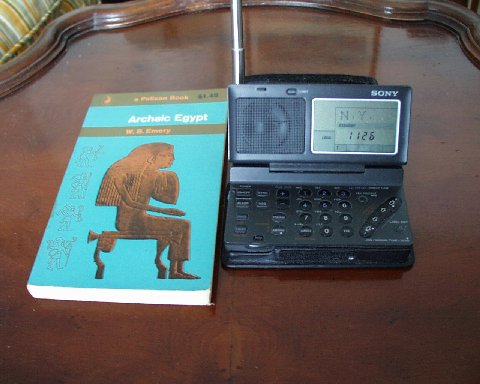Gerard M. Foley
Travel & Photography Collection
Short Wave Listening
While I was a student at the University of St. Andrews I was an enthusiastic short wave listener. The medium wave band used in the United States and most other countries for domestic (AM) broadcasting gives reception over 50-100 mile radius in the daytime, and up to a thousand or more miles at night. Guglielmo Marconi in 1921 had discovered that short waves could be received thousands of miles away from transmitters of modest power. It is these wavelengths that have since been used by amateurs to talk to each other all over the world, and which permit international broadcasting. With a little British battery powered "three valve" (three tube in American terminology) regenerative receiver I could listen to Boston and New York and Philadelphia radio broadcasts from my room in Scotland! I built, while I was at university, a large elaborate super heterodyne receiver which worked very well. Later I depended on commercially built receivers.
I have continued to be a short wave listener from time to time ever since. Now commercially built all wave receivers running off a few AA batteries, smaller than a paperback book,outperform the most elaborate, large and expensive of the vacuum tube receivers of an earlier day. Here is the one that sits by my bed when I am at home and goes with me when I travel

Short wave broadcast transmitters have changed over the years too. From 1000 watts (1 kw) or so in the mid 1920's the power increased to 10-50 kw by the end of the 1930's. Since then power has grown even more. Until recently the U.S. Federal Communications Commission refused to issue licences for short wave broadcasting unless the power exceeded 250 kw. U.S. private (commercial) short wave broadcasting is almost entirely "religious" now. The Voice of America and other government operated short wave services (Radio Europe, Radio Free Asia, Radio Marti and so on) indulge in more or less entertainment and information broadcasts, some with a good deal of propaganda thrown in. The latter is usually broaadcasst in languages other than English. The British Broadcasting Corporation World Service (which is paid for by the U.K.Foreign Office) is a very widely respected source of news and entertainment, with relay transmitters all over the world. North America is now served mainly by transmitters in the Caribbean. Radio Netherlands has a very limited but excellent schedule of news and information broadcasts, and uses several powerful relay transmitters, those for North America being on the Caribbean island of Bonaire. Deutsche Welle, the German short wave broadcast service, does most of its transmissions in its native language, as does Radio France International, although the latter has increased its English language service in recent years.
Many governments who used to have very large short wave broadcast operations have cut back in recent years. Radio Canada International, which used to be highly respected, is now only doing a little retransmission of domestic programs. Radio Australia has reduced the number of transmitters it uses, and puts more of its resources into broadcasting to Southeast Asia in appropriate languages than into English, but it is still an interesting source. Radio Australia uses short wave transmitters in Australia only, but its signals on 9580 KHz during North American mornings are easily heard. Radio Moscow, which used to broadcast in English 24 hours a day on an enormous number of transmitters, mostly in the USSR but some in Cuba and other friendly countries, has changed its name and reduced its operation substantially, but is still a very large broadcaster.
With the rise of satellite feeds to cable and broadcast television the interest of governments and others in providing short wave broadcasts is certainly declining. There is much discussion of the use of digital techniques, which are not compatible with ordinary receivers, and of direct satellite radio for public reception of international programs, working like the direct satellite TV that is now available in many parts of the world. For now, and for some time to come, there are many programs still available to the short wave listener.